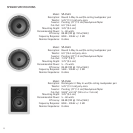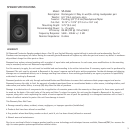
6
TAKING CARE OF YOUR NEW CEILING SPEAKERS
Russound Contractor speakers are designed to last the life of your home
if you follow a few simple rules.
The main “killers” of any loudspeaker system are:
• overdriving an underpowered amplifier
• too much power at high volumes
•transients (immediate loud passages, thumps, etc.)
Too little power:
It’s a surprising fact but far more speakers are damaged by too little
power than by too much. When an amplifier runs out of power while
trying to re-create musical peaks, it causes a form of high frequency dis-
tortion called clipping. Clipping simply makes the music sound distorted.
In greater quantities over a period of time, it can damage or destroy the
tweeters (high frequency speakers) in any speaker system. If you like
your music LOUD, consider getting an amplifier with at least 50 watts
per channel.
Too much power:
There’s nothing wrong with driving your Russound speakers with as
much as 80 watts per channel—the extra power helps them achieve
quick musical transients found in digital recordings. However, you must
remember to restrain yourself and not get too heavy-handed with the
volume control (or remote buttons). If the music begins to sound dis-
torted or you hear a “clacking” sound during bass notes, back off! The
clacking is caused by the woofer’s voice coil trying to come out of its
socket.
Transients:
Loud, deep THUMPS, caused when your system is turned on/off, or when
the tonearm is dropped too hard on a record (if you still use those great
classics), can seriously damage any loudspeaker including your Russound
Contractor models. Also remember to turn your system off before dis-
connecting any hook-up cables. When they’re pulled out, a huge burst
of low frequency hum often occurs if the system is still on.
MORE ON SPEAKER WIRES AND AMPLIFIER IMPEDANCE
Not all amplifiers or receivers can safely operate two sets of speakers at
once. If you intend to use your Russound Contractor speakers at the
same time as your main speakers or if you intend to hook up two pairs
of speakers and use both at the same time, it’s important to consider
both the impedance of the speakers and the capabilities of the amplifier
you’re using. Russound makes a complete line of products from
Impedance-Matching Volume Controls to Impedance-Matching Speaker
Selectors. Ask you Russound dealer for details or contact Russound Sales
at 603-659-5170.
First, consult the owner’s manual that came with the amp or receiver. It
should tell you the minimum speaker impedance during simultaneous
operation. On some models the manual will recommend that only two
pairs of 8-ohm speakers be used at the same time. Others might allow
one set of 8-ohm speakers and one set of 4-ohm impedance speakers. A
few extremely powerful receivers and power amplifiers may even allow
two sets of 4-ohm speakers.
If you can’t readily determine this information, consult the dealer where
you purchased the amplifier, or call the manufacturer of the product in
question. Next, determine the impedance of your other speakers. It’s
often printed on the back of the enclosure near the connection termi-
nals, or you can consult the speaker’s owner’s manual.
If your other speakers are rated at 4 ohms, some amplifiers may experi-
ence difficulty driving both 4-ohm sets at once and shut off intermit-
tently when the volume control is turned up. In this case, you should
operate only one set of speakers at a time or keep the volume extremely
low.
Another option is to purchase a speaker selector such as the Russound
SS-4.2 and SS-6.2 series or a PRO series speaker selector. These are
designed to maintain impedance control allowing your amplifier to work
efficiently.
INSTALLING DURING NEW CONSTRUCTION
Installing speakers when a house is being built is far easier than doing it
later. Russound offers Speaker Rough-In Brackets for round and rectan-
gular speakers . The bracket is designed to provide the drywall installers
with a cut-out for the In-Walls. Each kit comes with two brackets, (one
is required per speaker). The brackets are nailed/screwed onto the wall
studs. Once the house/room is completed, you can install the speaker.
• When it comes time to put up the dry wall, make sure the speaker
cut-out hole doesn’t extend farther than 1/4” from the sides of the
mounting frame.
• After the wallboard is put up, install the speakers as previously
detailed in this manual.
Figure 9
New construction
rough-in bracket
placement for ceiling
speaker














